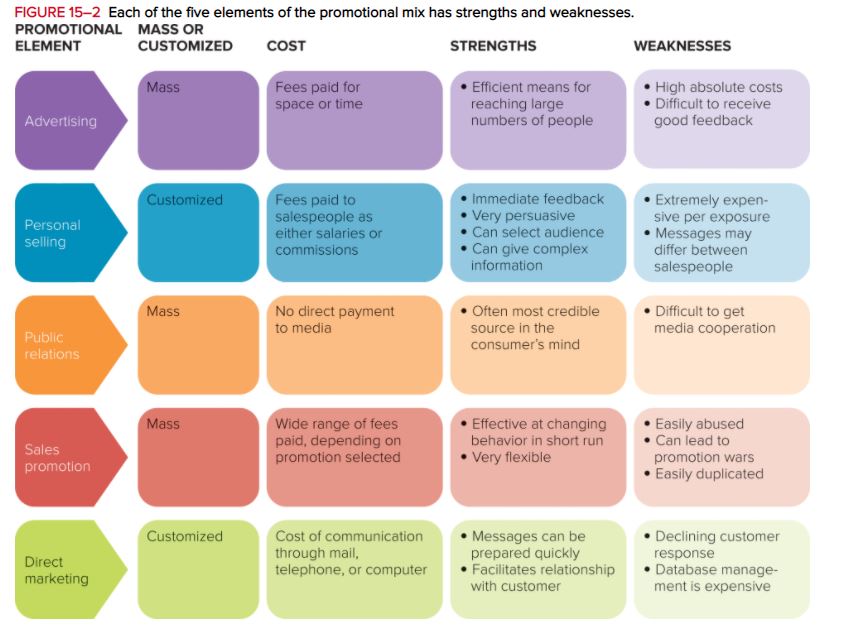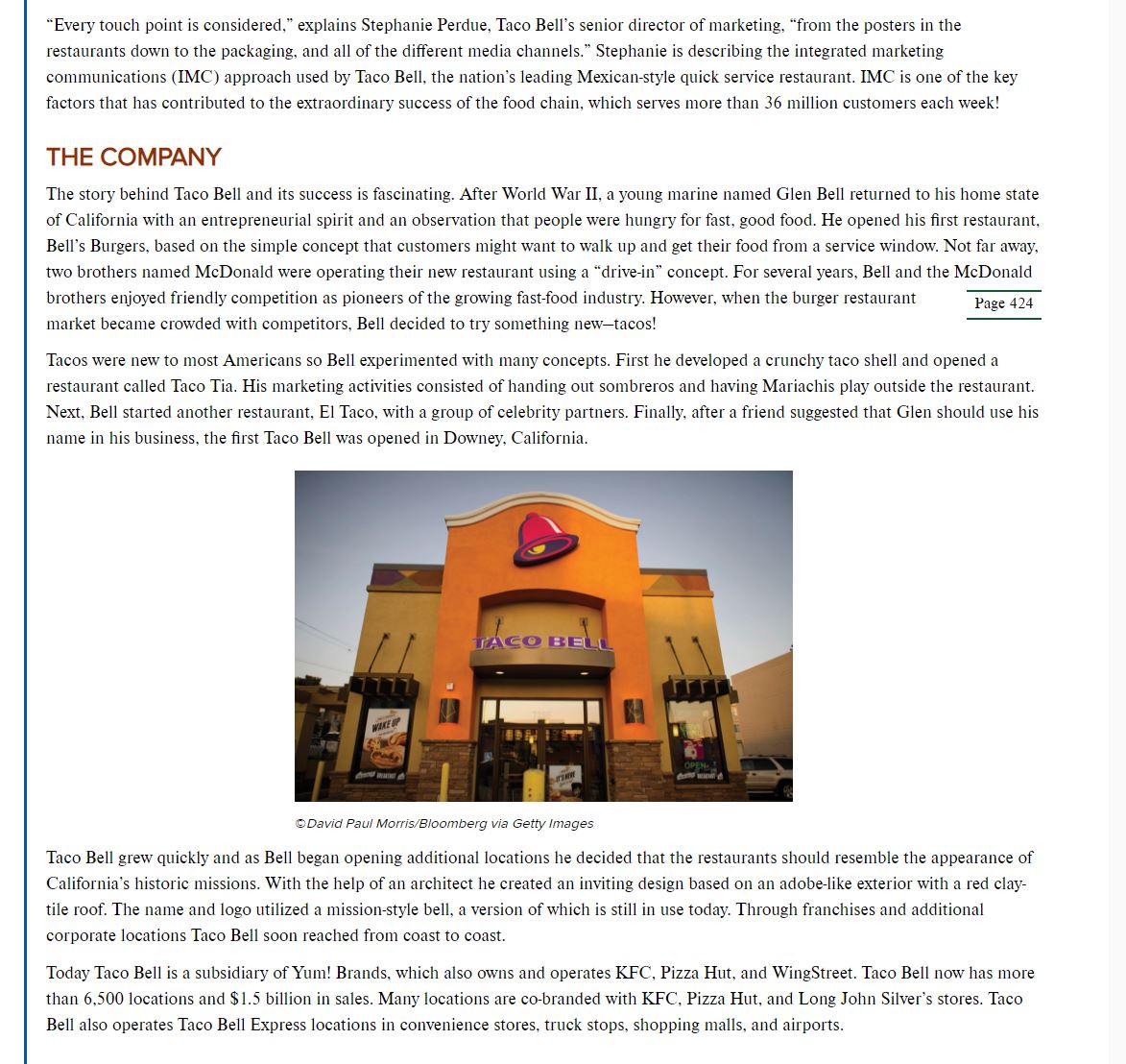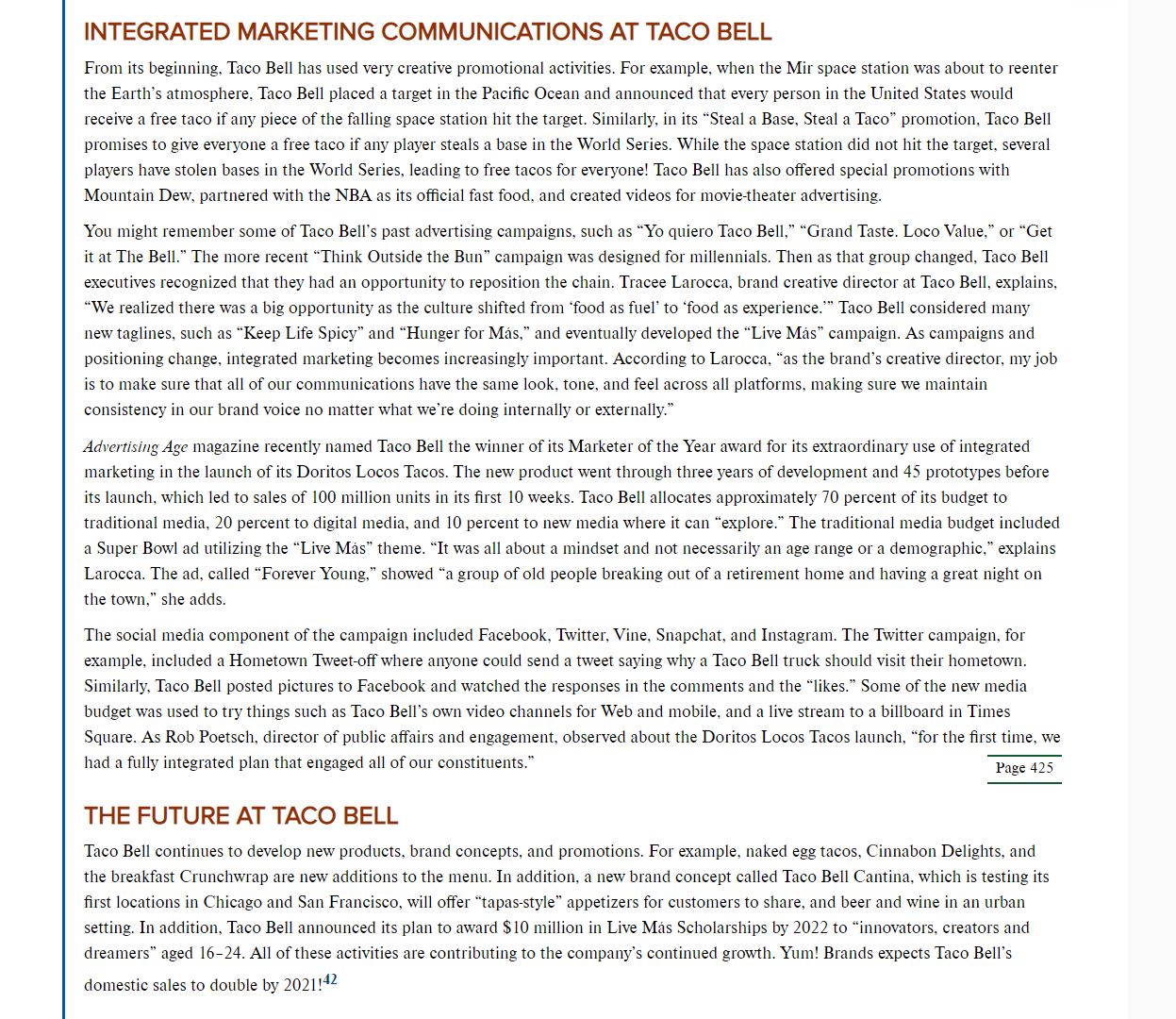Answers do not have to be long, just a few lines.
Integrated Marketing Communications and Direct Marketing
Read the case study on Taco Bell starting on page 423(attached 1)
\f"Every touch point is considered," explains Stephanie Perdue, Taco Bell's senior director of marketing, "from the posters in the restaurants down to the packaging, and all of the different media channels." Stephanie is describing the integrated marketing communications (IMC) approach used by Taco Bell, the nation's leading Mexican-style quick service restaurant. IMC is one of the key factors that has contributed to the extraordinary success of the food chain, which serves more than 36 million customers each week! THE COMPANY The story behind Taco Bell and its success is fascinating. After World War II, a young marine named Glen Bell returned to his home state of California with an entrepreneurial spirit and an observation that people were hungry for fast, good food. He opened his first restaurant, Bell's Burgers, based on the simple concept that customers might want to walk up and get their food from a service window. Not far away, two brothers named Mcdonald were operating their new restaurant using a "drive-in" concept. For several years, Bell and the Mcdonald brothers enjoyed friendly competition as pioneers of the growing fast-food industry. However, when the burger restaurant Page 424 market became crowded with competitors, Bell decided to try something new-tacos! Tacos were new to most Americans so Bell experimented with many concepts. First he developed a crunchy taco shell and opened a restaurant called Taco Tia. His marketing activities consisted of handing out sombreros and having Mariachis play outside the restaurant. Next, Bell started another restaurant, El Taco, with a group of celebrity partners. Finally, after a friend suggested that Glen should use his name in his business, the first Taco Bell was opened in Downey, California. TACO BELL WAKE UP David Paul Morris/Bloomberg via Getty Images Taco Bell grew quickly and as Bell began opening additional locations he decided that the restaurants should resemble the appearance of California's historic missions. With the help of an architect he created an inviting design based on an adobe-like exterior with a red clay- tile roof. The name and logo utilized a mission-style bell, a version of which is still in use today. Through franchises and additional corporate locations Taco Bell soon reached from coast to coast. Today Taco Bell is a subsidiary of Yum! Brands, which also owns and operates KFC, Pizza Hut, and WingStreet. Taco Bell now has more than 6,500 locations and $1.5 billion in sales. Many locations are co-branded with KFC, Pizza Hut, and Long John Silver's stores. Taco Bell also operates Taco Bell Express locations in convenience stores, truck stops, shopping malls, and airports.INTEGRATED MARKETING COMMUNICATIONS AT TACO BELL From its beginning, Taco Bell has used very creative promotional activities. For example, when the Mir space station was about to reenter the Earth's atmosphere, Taco Bell placed a target in the Pacific Ocean and announced that every person in the United States would receive a free taco if any piece of the falling space station hit the target. Similarly, in its "Steal a Base, Steal a Taco" promotion, Taco Bell promises to give everyone a free taco if any player steals a base in the World Series. While the space station did not hit the target, several players have stolen bases in the World Series, leading to free tacos for everyone! Taco Bell has also offered special promotions with Mountain Dew, partnered with the NBA as its official fast food, and created videos for movie-theater advertising You might remember some of Taco Bell's past advertising campaigns, such as "Yo quiero Taco Bell," "Grand Taste. Loco Value," or "Get it at The Bell." The more recent "Think Outside the Bun" campaign was designed for millennials. Then as that group changed, Taco Bell executives recognized that they had an opportunity to reposition the chain. Tracee Larocca, brand creative director at Taco Bell, explains, "We realized there was a big opportunity as the culture shifted from 'food as fuel' to 'food as experience." Taco Bell considered many new taglines, such as "Keep Life Spicy" and "Hunger for Mas," and eventually developed the "Live Mas" campaign. As campaigns and positioning change, integrated marketing becomes increasingly important. According to Larocca, "as the brand's creative director, my job is to make sure that all of our communications have the same look, tone, and feel across all platforms, making sure we maintain consistency in our brand voice no matter what we're doing internally or externally." Advertising Age magazine recently named Taco Bell the winner of its Marketer of the Year award for its extraordinary use of integrated marketing in the launch of its Doritos Locos Tacos. The new product went through three years of development and 45 prototypes before its launch, which led to sales of 100 million units in its first 10 weeks. Taco Bell allocates approximately 70 percent of its budget to traditional media, 20 percent to digital media, and 10 percent to new media where it can "explore. " The traditional media budget included a Super Bowl ad utilizing the "Live Mas" theme. "It was all about a mindset and not necessarily an age range or a demographic," explains Larocca. The ad, called "Forever Young," showed "a group of old people breaking out of a retirement home and having a great night on the town," she adds. The social media component of the campaign included Facebook, Twitter, Vine, Snapchat, and Instagram. The Twitter campaign, for example, included a Hometown Tweet-off where anyone could send a tweet saying why a Taco Bell truck should visit their hometown. Similarly, Taco Bell posted pictures to Facebook and watched the responses in the comments and the "likes." Some of the new media budget was used to try things such as Taco Bell's own video channels for Web and mobile, and a live stream to a billboard in Times Square. As Rob Poetsch, director of public affairs and engagement, observed about the Doritos Locos Tacos launch, "for the first time, we had a fully integrated plan that engaged all of our constituents." Page 425 THE FUTURE AT TACO BELL Taco Bell continues to develop new products, brand concepts, and promotions. For example, naked egg tacos, Cinnabon Delights, and the breakfast Crunchwrap are new additions to the menu. In addition, a new brand concept called Taco Bell Cantina, which is testing its first locations in Chicago and San Francisco, will offer "tapas-style" appetizers for customers to share, and beer and wine in an urban setting. In addition, Taco Bell announced its plan to award $10 million in Live Mas Scholarships by 2022 to "innovators, creators and dreamers" aged 16-24. All of these activities are contributing to the company's continued growth. Yum! Brands expects Taco Bell's domestic sales to double by 2021!42









